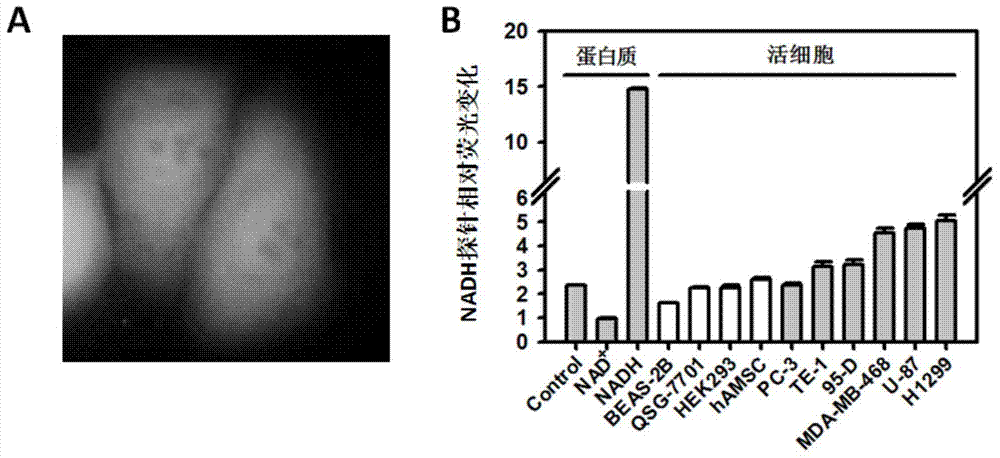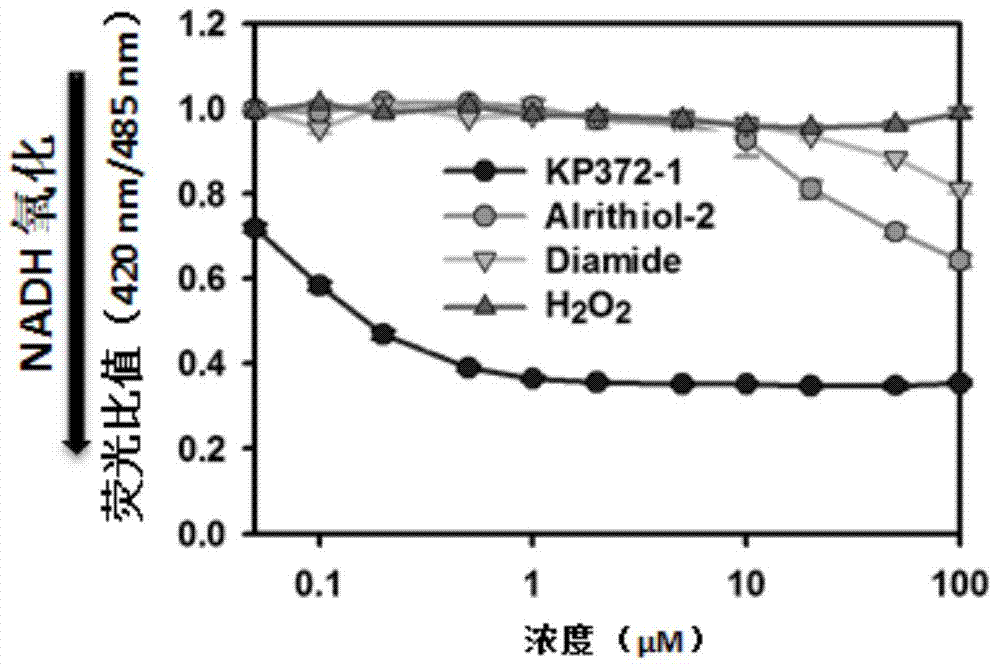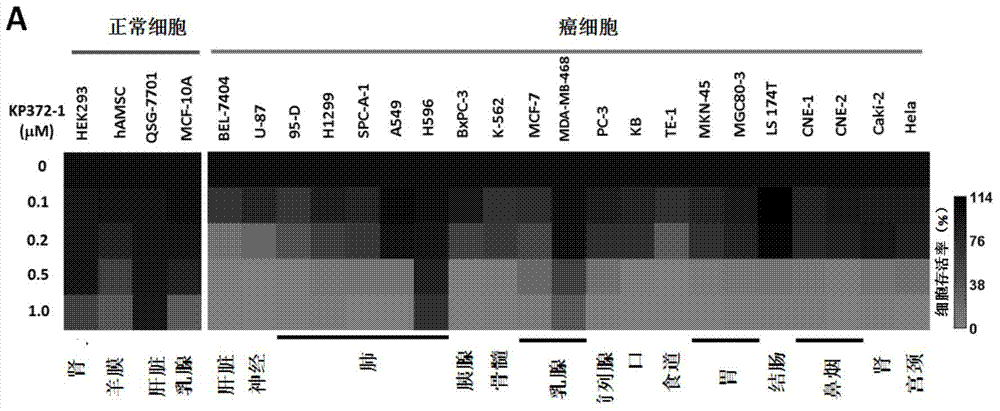Application of indeno triazine compounds as substrate of quinone oxidoreductase depending on NAD (P) H
An indenotriazine and compound technology, applied in the field of quinone oxidoreductase substrates, can solve the problems of high affinity, inability to detect changes in NAD+ levels, poor folding, etc.
- Summary
- Abstract
- Description
- Claims
- Application Information
AI Technical Summary
Problems solved by technology
Method used
Image
Examples
Embodiment 1
[0046] Example 1 The level of NADH in the cytoplasm of cancer cells is significantly higher
[0047] In the 1930s, German biochemist Otto Warburg discovered that tumor cells and normal cells have metabolic differences. They produce energy through glycolysis and produce a large amount of by-products-lactic acid (Warburg, O., etc., Science) .1956, V.123(3191), pp.309-314.). This metabolic property makes tumor cells consume sugar much faster than normal cells. This phenomenon of increased dependence of tumor cells on the production of glycolytic pathways is called the "Waberg effect", which will promote cell proliferation and tumor growth extremely quickly (Clower, CV, etc., Proc Natl Acad Sci USA. 2010, V .107(5), pp.1894-1899.). Previously, using NADH autofluorescence method, it was found that the level of NADH in tumor cells was relatively high (Villette, S. et al. Photochem Photobiol Sci. 2006, 5(5), pp.483-492. Uppal, A. et al., Biotechnol Appl Biochem. 2003, 37 (Pt1), pp. 4...
Embodiment 2
[0048] Example 2 KP372-1 significantly reduces NADH levels in cancer cells
[0049] We used NADH probes for high-throughput screening and found that a compound known as PDK1 / AKT / Flt3 dual pathway inhibitor-KP372-1 (Table 1) can significantly reduce the level of NADH in cancer cells ( figure 2 ). Mix the H1299 cell line stably expressing NADH probe with KP372-1 of different concentrations (0μM, 0.01μM, 0.02μM, 0.05μM, 0.1μM, 0.2μM, 0.5μM, 1.0μM, 2.0μM, 5.0μM, 10μM) , Add it to a black 96-well plate, use a multifunctional microplate reader to measure the fluorescence change of NADH probe at 420nm / 485nm, confirm that KP372-1 at 0.5μM can reduce the intracellular NADH level to the lowest level, and it is more than common Oxidant H 2 O 2 , Aldrithiol-2 and diamide are about 2000 times stronger ( figure 2 ).
Embodiment 3
[0050] Example 3 KP372-1 has a broad-spectrum anti-cancer effect
[0051] In order to further analyze the anti-cancer effect of KP372-1, we tested the effect of KP372-1 on the proliferation of cancer cells from different tissues. These cancer cells include: human liver cancer cell BEL-7404, human brain astrocytes Tumor U87, human high metastatic lung cancer cell 95-D, human non-small cell lung cancer cell NCI-H1299, human lung adenocarcinoma cell SPC-A-1, human lung cancer cell A549, human orthotopic pancreatic adenocarcinoma cell BxPC-3, human Chronic myeloid leukemia cells K562, human breast cancer cells MCF-7, human breast cancer cells MDA-MB-468, human prostate cancer cells PC-3, human oral epidermoid cancer cells KB, human esophageal cancer cells TE-1, human Gastric cancer cells MKN-45, human gastric cancer cells MGC80-3, human colon adenocarcinoma cells LS174T, human nasopharyngeal cancer cells CNE-1 and CNE-2, human renal clear cell cancer cells CaKi-2 and human Hela cervi...
PUM
 Login to View More
Login to View More Abstract
Description
Claims
Application Information
 Login to View More
Login to View More - R&D
- Intellectual Property
- Life Sciences
- Materials
- Tech Scout
- Unparalleled Data Quality
- Higher Quality Content
- 60% Fewer Hallucinations
Browse by: Latest US Patents, China's latest patents, Technical Efficacy Thesaurus, Application Domain, Technology Topic, Popular Technical Reports.
© 2025 PatSnap. All rights reserved.Legal|Privacy policy|Modern Slavery Act Transparency Statement|Sitemap|About US| Contact US: help@patsnap.com



